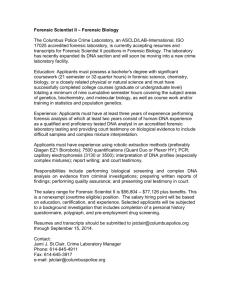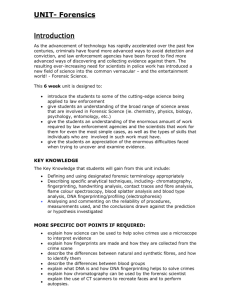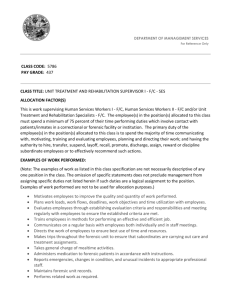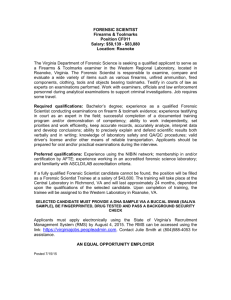Forensic Science
advertisement
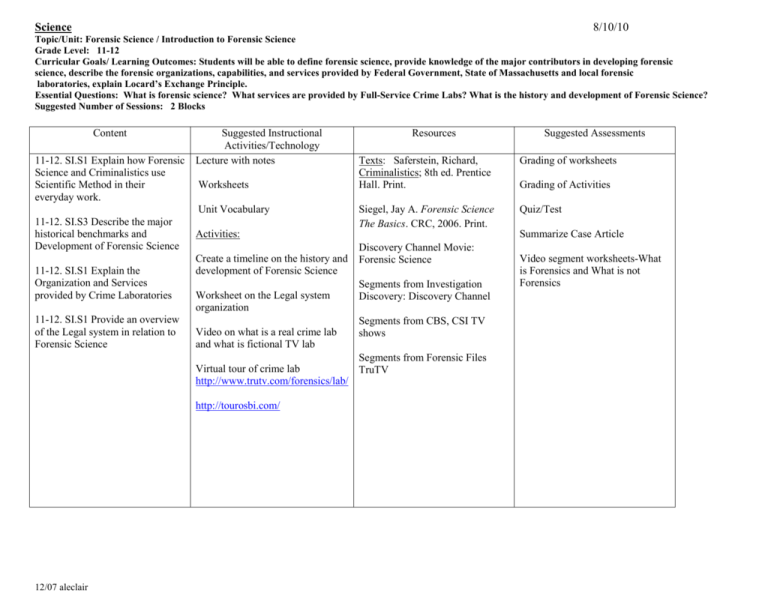
Science 8/10/10 Topic/Unit: Forensic Science / Introduction to Forensic Science Grade Level: 11-12 Curricular Goals/ Learning Outcomes: Students will be able to define forensic science, provide knowledge of the major contributors in developing forensic science, describe the forensic organizations, capabilities, and services provided by Federal Government, State of Massachusetts and local forensic laboratories, explain Locard’s Exchange Principle. Essential Questions: What is forensic science? What services are provided by Full-Service Crime Labs? What is the history and development of Forensic Science? Suggested Number of Sessions: 2 Blocks Content 11-12. SI.S1 Explain how Forensic Science and Criminalistics use Scientific Method in their everyday work. Suggested Instructional Activities/Technology Lecture with notes Worksheets Unit Vocabulary 11-12. SI.S3 Describe the major historical benchmarks and Development of Forensic Science 11-12. SI.S1 Explain the Organization and Services provided by Crime Laboratories 11-12. SI.S1 Provide an overview of the Legal system in relation to Forensic Science Resources Texts: Saferstein, Richard, Criminalistics; 8th ed. Prentice Hall. Print. Grading of worksheets Siegel, Jay A. Forensic Science The Basics. CRC, 2006. Print. Quiz/Test Worksheet on the Legal system organization Video on what is a real crime lab and what is fictional TV lab Discovery Channel Movie: Forensic Science Segments from Investigation Discovery: Discovery Channel Segments from CBS, CSI TV shows Segments from Forensic Files Virtual tour of crime lab TruTV http://www.trutv.com/forensics/lab/ http://tourosbi.com/ 12/07 aleclair Grading of Activities Summarize Case Article Activities: Create a timeline on the history and development of Forensic Science Suggested Assessments Video segment worksheets-What is Forensics and What is not Forensics Science 8/10/10 Topic/Unit: Forensic Science / Crime Scene Investigation Grade Level: 11-12 Curricular Goals/ Learning Outcomes: Students will be able to explain how to process the crime scene. Essential Questions: How do you secure and isolate the crime scene? How do you record the crime scene in its original state? What is the importance of maintaining the Chain of Custody? What are the legal considerations at the crime scene? Suggested Number of Sessions: 5 Blocks Content 11-12. SIS3 Explain the importance of Securing and Isolating the crime scene Suggested Instructional Activities/Technology Lecture with notes. Unit Vocabulary 11-12. SIS1 Explain legal implications if the Chain of Custody is broken Digital cameras 11-12. SIS2 Describe and demonstrate how to and record the crime scene: tag labels, photography, video recording, and sketching Computers Resources Texts: Saferstein, Richard; Criminalistics, 8th ed. Prentice Hall. Print. Grading of Lab Siegel, Jay A. Forensic Science The Basics. CRC, 2006. Print. Presentation of final sketches to courtroom (class) Quiz Walker, Pam. Crime scene investigations real-life science labs for grades 6-12. West Nyack, NY: Center for Applied Research in Education, 1998. Print. Famous Case readings/analysis Video Cameras Lab: Don’t touch the Evidence p. 37 (Lab on Crime Scene Evaluation) Segments from Forensic Files TruTV Segments from NBC Law & Order 12/07 aleclair Suggested Assessments Science 8/10/10 Topic/Unit: Forensic Science / Evidence Grade Level: 11-12 Curricular Goals/ Learning Outcomes: Students will be able to describe the different ways evidence can be categorized. Essential Questions: What are the differences between real and demonstrative evidence, known and unknown evidence, and class and individual evidence? What is identification and individualization? What are examples of positive and negative controls? What are positives and false negatives? Suggested Number of Sessions: 3 Block Content 11-12. SI.S1 Explain the various ways evidence can be classified Suggested Instructional Activities/Technology Lecture with notes Unit Vocabulary 11-12. SI.S3 Explain why analytical test must be verified to make sure they are working properly 12/07 aleclair Activity: Classify evidence found at crime scene p. 66 Resources Texts: Siegel, Jay A. and Kathy Mirakovits. Forensic Science: The Basics. Boca Raton, FL: CRC, 2010. Print. Suggested Assessments Quiz Chapter Test Yourself questions Science 8/10/10 Topic/Unit: Concept of pH, Spectrophotometer, Chromatography, Electrophoresis, Microscopy Grade Level: 11-12 Curricular Goals/ Learning Outcomes: Students will be able to explain the concept of Ph, define and characterize the different types of chromatography, explain the basic principles of electrophoresis, describe the wave nature of light, describe the effect of UV/visible light on matter and the types of matter that absorb these types of light, explain how a spectrophotometer is used and describe how microscopy is a powerful tool used in forensic science. Essential Questions: Suggested Number of Sessions: 7 Blocks Content 11-12. CH8:2 Become familiar with basic chemistry concepts such as pH, separating solids, and polarity 11-12. SI.S3 Compare the basic differences of chromatography techniques commonly used in forensic science 11-12. SI.S3 Understand the differences between thin-layer chromatography and gel electrophoresis Suggested Instructional Activities/Technology Lecture with notes. Unit Vocabulary/Chapter Questions Exploration /Solve Activities On the Web activities at the end of chapters 4, 5, & 6 Labs: Picking up the pieces (fiber analysis) p. 119 Resources Texts: Saferstein, Richard. Criminalistics. 8th ed. Prentice Hall. 2004 Print. Siegel, Jay A., and Kathy Mirakovits. Forensic Science: the Basics. Boca Raton, FL: CRC, 2010. Print. Walch. Top Shelf Forensics (Top Shelf Science Series Ser). Portland: Walch Pub. 2003. Print. Chromatography of dyes p. 50 11-12. PHYSICS 6:2 Explain why the areas of the electromagnetic spectrum (UV/visible light) are of most interest to forensic scientist 11-12. SI.S4 Compare the different types of microspy used by forensic scientists to analyze evidence 12/07 aleclair A Pool of yellow evidence (urine analysis –pH) p. 128 What is the White Powder p. 199 Chromatography p. 197 Microscopes – How to use properly Saferstein, Richard. Forensic Science: An Introduction. 2nd ed. Prentice Hall. 2011. Print. Suggested Assessments Quiz/Test Grading Activity worksheets Teacher observations using activity rubric during exploration activity and projects Science 8/10/10 Topic/Unit: Fingerprints and Other Impressions Grade Level: 11-12 Curricular Goals/ Learning Outcomes: Students will be able to know the common ridge characteristics of a fingerprint, name and describe the physical and chemical detection of fingerprints, describe the concept of an automated fingerprint identification system (AFIS), list the technique for developing latent fingerprints on porous and nonporous, and explain the various types of impression evidence. Essential Questions: Suggested Number of Sessions: 8 Blocks Content 11-12. SI.S3 Three (3) Fundamental Principles of Fingerprints: no identical ridge patterns, general ridge patterns permit systematic classification, and fingerprints remain unchanged during an individuals lifetime 11-12. SI.S4 Distinguish visible, plastic, and latent fingerprints and how to detect each type 11-12.SI.S2 How to preserve / develop fingerprints 11-12. SI.S2 How footwear impressions are formed 11-12. SI.S2 How to identify tire tread impressions 11-12. PHYSICS: 1:1, 1:2, 1:3 Describe techniques for rifling a barrel 12/07 aleclair Suggested Instructional Activities/Technology Lecture with notes Unit Vocabulary Exploration /Solve Activities Activities: On the web p. 176 Mini Lab 2: Henry Classification of Your Fingerprints p.171 The case of the Telling Fingerprint p. 56 Fingerprints Lab p. 60 Making impression Casts of footprints and tire treads p.59 Resources Texts: Saferstein, Richard. Criminalistics; 8th ed. Prentice Hall. 2011. Print. Siegel, Jay A., and Kathy Mirakovits. Forensic Science: the Basics. Boca Raton, FL: CRC, 2010. Print Rainis, Kenneth G. Fingerprints: Crime-solving Science Experiments. Berkeley Heights, NJ: Enslow, 2006. Print. Rainis, Kenneth G. Hair, Clothing and Tire Track Evidence: Crimesolving Science Experiments. Berkeley Heights, NJ: Enslow, 2006. Print. Possible Guest Speaker – Police Dept.and local Forensic Engineer Suggested Assessments Quiz/Test Grading Activity worksheets chapter review questions Teacher observations using activity rubric during exploration activity and projects Science 8/10/10 Topic/Unit: Questioned Documents Grade Level: 11-12 Curricular Goals/ Learning Outcomes: Students will be able to define a questioned document, describe the methods for analyzing and comparing Handwriting, describe methods for uncovering erasures and other obliterations and variations in pen inks, describe the methods of analysis of copier toners and printers, and describe how forgeries and tracing are detected. Essential Questions: Suggested Number of Sessions: 6 Blocks Content 11-12. SI.S2 Characteristics used for comparison of handwriting (handwriting analysis) 11-12. SI.S3 Several type of methods used to alter documents 11-12. SI.S3 Recognize the class and individual characteristics of typewriters, photocopiers, and computer printers Suggested Instructional Activities/Technology Lecture with notes. Unit Vocabulary Exploration /Solve Activities Activities: Quicklab: p. 647 Handwriting comparison Case # 5: The Case of the Windsor Note p. 68 Case # 6 : The Case of the Questioned Photocopy p. 75 12/07 aleclair Resources Texts: Saferstein, Richard. Criminalistics. 8th ed. Prentice Hall. 2011. Print. Siegel, Jay A., and Kathy Mirakovits. Forensic Science: the Basics. Boca Raton, FL: CRC, 2010. Print. Saferstein, Richard. Forensic Science: An Introduction. 2nd ed. Prentice Hall. 2011. Print. Rainis, Kenneth G. Forgery: Crime-solving Science Experiments. Berkeley Heights, NJ: Enslow, 2006. Print. Suggested Assessments Quiz/Test Grading Activity worksheets chapter review questions Teacher observations using activity rubric during exploration activity and projects Science 8/11/10 Topic/Unit: Firearms and Toolmarks Grade Level: 11-12 Curricular Goals/ Learning Outcomes: Students will be able to define toolmark analysis and toolmarks, define firearm analysis and its scope, define and list the various types of weapons, define and give examples of stria, describe the various types of markings left on bullets and cartridges by weapons, describe how bullets and cartridges are matched to a particular weapon, describe how distance-of-firing determinations are made with rifled weapons and shotguns, describe the various types of propellants and primers used in weapons, describe other toolmarks, and describe how serial number restorations are accomplished and the principle behind them Essential Questions: Suggested Number of Sessions: 8 Blocks Content 11-12. SI.S1 Methods used in firearms Identification Suggested Instructional Activities/Technology Lecture with notes Unit Vocabulary 11-12. PHYSICS 1:1, 1:2, 1:3 Define rifling and how it how it occurs in firearms 11-12. PHYSICS 1:1 Explain the anatomy of a live round Exploration /Solve Activities Activities: Quicklab: Toolmarks p. 617 Lab: Tool Marks the Spot p. 77 11-12. SI.S2 Describe how propellants and primers are used in weapons 11-12 SI.S2 Explain how scientists examine firearm evidence 11-12. PHYSICS 1:1 Explain how distance-of-fire is determined in a crime investigation 11-12. SI.S1 Describe various types of toolmarks 12/07 aleclair Mini Research on JFK assassination www.school.cengage.com/forensics cience (determining the location of the shooter and trajectory) Bullet Trajectory Activity p. 507 Field Trip or Guest Speaker: Smith & Wesson Resources Texts: Saferstein, Richard. Criminalistics; 8th ed. Prentice Hall. 2011. Print. Siegel, Jay A., and Kathy Mirakovits. Forensic Science: the Basics. Boca Raton, FL: CRC, 2010. Print. Saferstein, Richard. Forensic Science: An Introduction. 2nd ed. Prentice Hall. 2011. Print. Walker, Pam. Crime scene investigations real-life science labs for grades 6-12. West Nyack, NY: Center for Applied Research in Education, 1998. Print. Bertino, Anthony. Forensic Science Fundamentals & Investigation. Scotia, NY: South-Western, 2008. Print. Suggested Assessments Quiz/Test Grading Activity worksheets chapter review questions Famous Case readings/analysis Teacher observations using activity rubric during exploration activity and projects Science 8/11/10 Topic/Unit: Firearms and Toolmarks Grade Level: 11-12 Curricular Goals/ Learning Outcomes: Students will be able to define toolmark analysis and toolmarks, define firearm analysis and its scope, define and list the various types of weapons, define and give examples of stria, describe the various types of markings left on bullets and cartridges by weapons, describe how bullets and cartridges are matched to a particular weapon, describe how distance-of-firing determinations are made with rifled weapons and shotguns, describe the various types of propellants and primers used in weapons, describe other toolmarks, and describe how serial number restorations are accomplished and the principle behind them Essential Questions: Suggested Number of Sessions: 8 Blocks 12/07 aleclair Science 8/11/10 Topic/Unit: Firearms and Toolmarks Grade Level: 11-12 Curricular Goals/ Learning Outcomes: Students will be able to define toolmark analysis and toolmarks, define firearm analysis and its scope, define and list the various types of weapons, define and give examples of stria, describe the various types of markings left on bullets and cartridges by weapons, describe how bullets and cartridges are matched to a particular weapon, describe how distance-of-firing determinations are made with rifled weapons and shotguns, describe the various types of propellants and primers used in weapons, describe other toolmarks, and describe how serial number restorations are accomplished and the principle behind them Essential Questions: Suggested Number of Sessions: 8 Blocks 12/07 aleclair Science 8/11/10 Topic/Unit: Forensic Pathology & Entomology Grade Level: 11-12 Curricular Goals/ Learning Outcomes: Students will be able to define forensic pathology, distinguish between the four manners of death: natural, accidental, suicidal, and homicidal, explain how the development of rigor, algor, and livor mortis occurs following death, describe the stages of decomposition of a corpse, define and describe an autopsy and explain when a coroner or medical examiner must perform an autopsy, explain how time of death can be estimated using insect evidence, describe the contributions that forensic entomology can make in solving death cases, describe ways forensic entomology can help determine the postmortem interval, list and describe various types of arthropods that invade a body after death, describe the contributions of forensic entomology to the determination of the presence of drugs and poisons in the body, explain how the time of death can be estimated using the autopsy report on stomach contents Essential Questions: Suggested Number of Sessions: 5 Blocks Content 11-12. B4:8 Define the meaning of the manner of death Suggested Instructional Activities/Technology Lecture with notes Unit Vocabulary 11-12. Explain the various methods used to determine the time of death 11-12. Explain how insects are used to help determine the time of death 11-12. SI.S3 Define Medicolegal autopsy 11-12. SI.S1 Explain the autopsy process Calculating time of death using rigor mortis p. 326 Insect study p. 331 Estimation of time of death using insect, algor, and livor mortis p.334 Use dissecting microscopes to analyze Blowfly On the Web Activities p. 251 11-12. SI.S4 Describe the various patterns of injury and classification of violent deaths 11-12. Explain and describe the life-cycle of the Blowfly 12/07 aleclair Suggested Assessments Texts: Saferstein, Richard. Criminalistics; 8th ed. Prentice Hall. 2011. Print. Quiz/Test Siegel, Jay A., and Kathy Mirakovits. Forensic Science: the Basics. Boca Raton, FL: CRC, 2010. Print. Famous Case readings/analysis Grading Activity worksheets chapter review questions Exploration /Solve Activities Activities: 11-12. B6:3 Describe the stages of decomposition in humans and other animals Resources Possible guest speaker: Pathologist or Medical examiner Saferstein, Richard. Forensic Science: An Introduction. 2nd ed. Prentice Hall. 2011. Print. Bertino, Anthony. Forensic Science Fundamentals & Investigation. Scotia, NY: SouthWestern, 2008. Print. Siegel, Jay A., and Kathy Mirakovits. Forensic Science: the Basics. Boca Raton, FL: CRC, 2010. Print Teacher observations using activity rubric during exploration activity and projects Science 8/11/10 Topic/Unit: Forensic Pathology & Entomology Grade Level: 11-12 Curricular Goals/ Learning Outcomes: Students will be able to define forensic pathology, distinguish between the four manners of death: natural, accidental, suicidal, and homicidal, explain how the development of rigor, algor, and livor mortis occurs following death, describe the stages of decomposition of a corpse, define and describe an autopsy and explain when a coroner or medical examiner must perform an autopsy, explain how time of death can be estimated using insect evidence, describe the contributions that forensic entomology can make in solving death cases, describe ways forensic entomology can help determine the postmortem interval, list and describe various types of arthropods that invade a body after death, describe the contributions of forensic entomology to the determination of the presence of drugs and poisons in the body, explain how the time of death can be estimated using the autopsy report on stomach contents Essential Questions: Suggested Number of Sessions: 5 Blocks 12/07 aleclair Science 8/11/10 Topic/Unit: Anthropology and Odontology Grade Level: 11-12 Curricular Goals/ Learning Outcomes: Students will be able to define forensic anthropology, describe the development and structure of bones, describe the various components of the biological profile, describe the various anthropological tests that can be done on skulls to help identify them, list and describe the various way forensic odontology is used in forensic science. Essential Questions: Suggested Number of Sessions: 8 Blocks Content 11-12. B4:5 Describe the development of Human Skeleton – Bone structure 11-12. Learn how scientists use Identify skeletal remains 11-12. B5:1 Understand the significance of identifying the age of bone remains Suggested Instructional Activities/Technology Lecture with notes Unit Vocabulary Exploration /Solve Activities Activities: Determining the age of a skull p. 380 Bones: Male or Femalep.381 11-12. Describe how scientists profile biological remains 11-12. B4:5 Describe the different types of bone trauma and individual features 11-12. Explain and describe how to analyze skull remains 11-12. Describe the structure and development of teeth 11-12. B5:1 Explain how scientists identify dental remains 11-12. B4:5 Describe how bite marks patterns are analyzed 11-12. Explain how Forensic Odontology is used in abuse cases 12/07 aleclair Medical Examiner’s Findings p.388 Resources Suggested Assessments Texts: Saferstein, Richard. Criminalistics; 8th ed. Prentice Hall. 2011. Print. Quiz/Test Siegel, Jay A., and Kathy Mirakovits.: Forensic Science the Basics. Boca Raton, FL: CRC, 2010. Print. Famous Case readings/analysis Saferstein, Richard. Forensic Science: An Introduction. 2nd ed. Prentice Hall. 2011. Print. Bertino, Anthony. Forensic Science Fundamentals & Investigation. Scotia, NY: SouthWestern, 2008. Print. Grading Activity worksheets chapter review questions Teacher observations using activity rubric during exploration activity and projects Science 8/11/10 Topic/Unit: Anthropology and Odontology Grade Level: 11-12 Curricular Goals/ Learning Outcomes: Students will be able to define forensic anthropology, describe the development and structure of bones, describe the various components of the biological profile, describe the various anthropological tests that can be done on skulls to help identify them, list and describe the various way forensic odontology is used in forensic science. Essential Questions: Suggested Number of Sessions: 8 Blocks 12/07 aleclair Science 8/11/10 Topic/Unit: Anthropology and Odontology Grade Level: 11-12 Curricular Goals/ Learning Outcomes: Students will be able to define forensic anthropology, describe the development and structure of bones, describe the various components of the biological profile, describe the various anthropological tests that can be done on skulls to help identify them, list and describe the various way forensic odontology is used in forensic science. Essential Questions: Suggested Number of Sessions: 8 Blocks 12/07 aleclair Science 8/11/10 Topic/Unit: Serology, Bloodstain patterns and other bodily fluids Grade Level: 11-12 Curricular Goals/ Learning Outcomes: Students will be able to define and describe the components of blood, describe various types of preliminary tests for blood, define semen and describe its components, describe the preliminary and confirmatory tests for semen, describe the common tests for vaginal secretions, describe the common tests for saliva, describe the role of bloodstain pattern analysis in crime scene reconstruction, describe the physical properties of blood and how they contribute to the various types of bloodstains, and describe the various types of bloodstains. Essential Questions: Suggested Number of Sessions: 9 Blocks Content 11-12. B4:2 Describe the components of Blood Suggested Instructional Activities/Technology Lecture with notes Unit Vocabulary 11-12. Explain how scientist analyze blood Activities: Quicklab: Blood Typing p. 395 11-12. PHYSICS 1:1, 1:2 Explain how scientists analyze bloodstain patterns at a crime scene Lab: Bloodstains on the Ground p. 199 12/07 aleclair Suggested Assessments Texts: Saferstein, Richard. Criminalistics; 8th ed. Prentice Hall. 2011. Print. Quiz/Test Siegel, Jay A., and Kathy Mirakovits. Forensic Science: the Basics; Boca Raton, FL: CRC, 2010. Print. Famous Case readings/analysis Grading Activity worksheets chapter review questions Exploration /Solve Activities 11-12. Describe the methods used as confirmatory blood tests 11-12. B4:6 & B4:2 Explain the biochemical composition of seminal fluid, vaginal secretions, and saliva Resources Lab: Cold Blood - A Lab on Blood-drop Analysis Discussion and readings from the OJ Simpson case Saferstein, Richard. Forensic Science: An Introduction; 2nd ed. Prentice Hall. 2011. Print. Walker, Pam. Crime Scene Investigations : Real-life Science Labs for Grades 6-12. West Nyack, NY: Center for Applied Research in Education, 1998. Print. Teacher observations using activity rubric during exploration activity and projects Science 8/11/10 Topic/Unit: Serology, Bloodstain patterns and other bodily fluids Grade Level: 11-12 Curricular Goals/ Learning Outcomes: Students will be able to define and describe the components of blood, describe various types of preliminary tests for blood, define semen and describe its components, describe the preliminary and confirmatory tests for semen, describe the common tests for vaginal secretions, describe the common tests for saliva, describe the role of bloodstain pattern analysis in crime scene reconstruction, describe the physical properties of blood and how they contribute to the various types of bloodstains, and describe the various types of bloodstains. Essential Questions: Suggested Number of Sessions: 9 Blocks 12/07 aleclair Science 8/11/10 Topic/Unit: Serology, Bloodstain patterns and other bodily fluids Grade Level: 11-12 Curricular Goals/ Learning Outcomes: Students will be able to define and describe the components of blood, describe various types of preliminary tests for blood, define semen and describe its components, describe the preliminary and confirmatory tests for semen, describe the common tests for vaginal secretions, describe the common tests for saliva, describe the role of bloodstain pattern analysis in crime scene reconstruction, describe the physical properties of blood and how they contribute to the various types of bloodstains, and describe the various types of bloodstains. Essential Questions: Suggested Number of Sessions: 9 Blocks 12/07 aleclair Science 8/11/10 Topic/Unit: DNA Typing Grade Level: 11-12 Curricular Goals/ Learning Outcomes: Students will be able to define DNA and describe its structure, describe the precautions necessary when collecting biologic evidence, describe how RFLP DNA typing is carried out, describe how PCR is carried out and how DNA can be typed by PCR, describe how STRs are measured, describe how population frequency statistics are used to describe the significance of a DNA match, define mitochondrial DNA and describe how it is typed, Define CODIS and describe its structure and how it is used in criminal investigation Essential Questions: Suggested Number of Sessions: 8 Blocks Content 11-12. B3:1 Describe DNA components and structure Suggested Instructional Activities/Technology Lecture with notes Unit Vocabulary 11-12. B3:2 Explain the process of DNA Replication 11-12. Explain the procedures used in Polymerase Chain Reaction (PCR) 11-12. Describe how scientists use DNA typing with Tandem Repeats (RFLP, STRs, and Electrophoresis) to determine a DNA match to solve a crime 11-12. B3:1 Define Mitochondrial DNA and explain the importance of mDNA in finding a DNA match 11-12. SI.S2 Explain the procedure for collection and preservation of DNA evidence 11-12. SI.S4 Define Combined DNA Index System (CODIS) and explain how it is used 12/07 aleclair Exploration /Solve Activities Resources Texts: Saferstein, Richard. Criminalistics; 8th ed. Prentice Hall, 2011. Print. Siegel, Jay A., and Kathy Activities: Mirakovits; Forensic Science: the Inspector’s DNA Casebook project Basics, Boca Raton, FL: CRC, p.73 2010. Print Who are the Parents? P.187 Saferstein, Richard. Forensic Science: An Introduction. 2nd ed. Virtual Labs: PCR and Gel Prentice Hall. 2011. Print. electrophoresis http://learn.genetics.utah.edu/ Lab: Electrophoresis lab OJ Simpson case Analysis Readings Rainis, Kenneth G.; Blood and DNA Evidence: Crime-Solving Science Experiments, Berkeley Heights, NJ: Enslow, 2006. Print. Bertino, Anthony; Forensic Science Fundamentals & Investigation, Scotia, NY: SouthWestern, 2008. Print. Suggested Assessments Quiz/Test Grading Activity worksheets chapter review questions Famous Case readings/analysis Teacher observations using activity rubric during exploration activity and projects Science 8/11/10 Topic/Unit: DNA Typing Grade Level: 11-12 Curricular Goals/ Learning Outcomes: Students will be able to define DNA and describe its structure, describe the precautions necessary when collecting biologic evidence, describe how RFLP DNA typing is carried out, describe how PCR is carried out and how DNA can be typed by PCR, describe how STRs are measured, describe how population frequency statistics are used to describe the significance of a DNA match, define mitochondrial DNA and describe how it is typed, Define CODIS and describe its structure and how it is used in criminal investigation Essential Questions: Suggested Number of Sessions: 8 Blocks 12/07 aleclair Science 8/11/10 Topic/Unit: DNA Typing Grade Level: 11-12 Curricular Goals/ Learning Outcomes: Students will be able to define DNA and describe its structure, describe the precautions necessary when collecting biologic evidence, describe how RFLP DNA typing is carried out, describe how PCR is carried out and how DNA can be typed by PCR, describe how STRs are measured, describe how population frequency statistics are used to describe the significance of a DNA match, define mitochondrial DNA and describe how it is typed, Define CODIS and describe its structure and how it is used in criminal investigation Essential Questions: Suggested Number of Sessions: 8 Blocks 12/07 aleclair Science 8/12/10 Topic/Unit: Forensic Science: Physical Evidence (hair, fibers, glass, paint, and soil) Grade Level: 11-12 Curricular Goals/ Learning Outcomes: Students will be able to describe in detail the common types of Physical Evidence Essential Questions: Why is evidence admissible? What is the significance of physical evidence? Why is comparative analysis an important procedure in determining whether or not a suspect specimen and a standard/reference have a common origin? What is the importance of the process of Identification of physical evidence. What is meant by evidence possessing individual or class characteristics? What hair features are useful for microscopic comparison of human hairs? What are the properties of fibers that are most useful for forensic comparison? What is the proper collection of soil evidence? What is the proper collection and useful examination for performing a forensic comparison of paint? What is the proper collection and preservation of forensic paint evidence? Suggested Number of Sessions: 10 Blocks Content 11-12. SI.S1 Recognize what is good evidence? Compare direct evidence to physical evidence Suggested Instructional Activities/Technology Lecture with notes Unit Vocabulary 11-12. B:1, CH 7:4 Describe common types of Physical Evidence (trace evidence: hair, fibers, paint, soil, and glass) Exploration /Solve Activities 11-12. SI.S4 Describe methods used to collect and preserve trace evidence Activites: Exploration Activity p.8 Solve Activity: Robbery p. 11 Possible guest speaker from MA State Crime Lab Project: Making a hair and fiber reference collection p.36 Analyzing Paint Chips p.81 Lab: Glass is Breaking Up p.85 Resources Texts: Saferstein, Richard; Criminalistics, 8th ed. Prentice Hall. Print. Siegel, Jay A., and Kathy Mirakovits; Forensic Science: the Basics. Boca Raton, FL: CRC, 2010. Print Walch. Top Shelf Forensics (Top Shelf Science Series Ser). Portland: Walch Pub., 2003. Print. Rainis, Kenneth G. Hair, Clothing and Tire Track Evidence: Crimesolving Science Experiments. Berkeley Heights, NJ: Enslow, 2006. Print. Walker, Pam, and Elaine Wood. Crime Scene Investigations: Reallife Science Labs for Grades 6-12. San Francisco, CA: Jossey-Bass, 1998. Print. 12/07 aleclair Suggested Assessments Quiz/Test Grading Activity worksheets Teacher observations using activity rubric during exploration activity and projects Science 8/12/10 Topic/Unit: Illicit Drugs and Forensic toxicology Grade Level: 11-12 Curricular Goals/ Learning Outcomes: Students will be able to define a drug and distinguish licit drugs from illicit ones, describe the classification of drugs by major effect , understand the proper collection and preservation of drug evidence, and describe how an illicit drug is analyzed correctly by forensic chemist. Essential Questions: Suggested Number of Sessions: 6 Blocks Content 11-12. B4:4 Define the different types of drugs and their chemical effects on the body Suggested Instructional Activities/Technology Lecture with notes Unit Vocabulary 11-12. Explain the Drug-Control Laws Exploration /Solve Activities 11-12. SI.S1Explain how Forensic Chemists performs drug analysis Activities: 11-12. Describe how law enforcement personnel should collect and preserve of drug Evidence 11-12. CH8:2 Describe the principles of Pharmacology (drug intake, circulation of drugs in the bloodstream, elimination of drugs, metabolism, synergism, tolerance, addiction verses dependence) 11-12. Explain the pharmacology and toxicology of Ethyl-Alcohol 11-12. B4:4 Explain the methods uses to determine how much drinking does it take to get drunk 11-12. Measurement of BAC 11-12. SI.S2 Field Sobriety Tests 12/07 aleclair Quicklab: pH Test p. 247 Drug Identification (Tylenol, Motrin, Aleve) p. 271 Virtual tour: Alcohol Analyzer http://agora.virtualmuseum.ca/edu/Vie wLoitLo.do?method=preview&lang= EN&id=5229 Possible guest speaker (DEA) or local Police Resources Texts: Saferstein, Richard. Criminalistics; 8th ed. Prentice Hall. 2011. Print. Siegel, Jay A., and Kathy Mirakovits. Forensic Science: the Basics; Boca Raton, FL: CRC, 2010. Print Saferstein, Richard. Forensic Science: An Introduction; 2nd ed. Prentice Hall. 2011. Print. Bertino, Anthony. Forensic Science Fundamentals & Investigation; Scotia, NY: South-Western, 2008. Print. Suggested Assessments Quiz/Test Grading Activity worksheets chapter review questions Famous Case readings/analysis Teacher observations using activity rubric during exploration activity and projects Science 8/12/10 Topic/Unit: Illicit Drugs and Forensic toxicology Grade Level: 11-12 Curricular Goals/ Learning Outcomes: Students will be able to define a drug and distinguish licit drugs from illicit ones, describe the classification of drugs by major effect , understand the proper collection and preservation of drug evidence, and describe how an illicit drug is analyzed correctly by forensic chemist. Essential Questions: Suggested Number of Sessions: 6 Blocks 12/07 aleclair Science 8/12/10 Topic/Unit: Fires and Explosions Grade Level: 11-12 Curricular Goals/ Learning Outcomes: Students will be able to define fire and explosion, give examples of arson and incendiary fires, define combustion and give examples of combustion reactions, describe how fire and explosion scenes are investigated and what evidence is sought, and describe methods for the laboratory analysis of fire and explosion debris. Essential Questions: Suggested Number of Sessions: 5 Blocks Content 11-12. CH 1:1, 1:2, 3:1 Describe the chemical composition of various fires Suggested Instructional Activities/Technology Lecture with notes Unit Vocabulary 11-12. SI.S3 Explain the methods used to Extinguish fires 11-12. SI.S1 Define incendiary fires 11-12. Explain the various causes of fires 11-12. Describe investigators determine the fire point of origin 11-12. CH 1:1 Describe how accelerants play a role in a fire 11-12. SI.S1Describe how investigators analyze of fire scene evidence 11-12. Explain the causes of explosions 11-12. Explain the methods used to Investigate bombing scenes 12/07 aleclair Exploration /Solve Activities Activities: The Flame test http://imagine.gsfc.nasa.gov/docs/teac hers/lessons/xray_spectra/studentworksheet-flame.html Hunt for the Serial Arsonist - Nova http://www.pbs.org/wgbh/nova/teache rs/activities/2214_arsonist.html CSI web adventures http://forensics.rice.edu/ Possible Arson squad guest speaker Resources Suggested Assessments Texts: Saferstein, Richard. Forensic Science: An Introduction; 2nd ed. Prentice Hall. 2011. Print. Quiz/Test Siegel, Jay A., and Kathy Mirakovits. Forensic Science: the Basics; Boca Raton, FL: CRC, 2010. Print Famous Case readings/analysis Grading Activity worksheets chapter review questions Teacher observations using activity rubric during exploration activity and projects Science 8/12/10 Topic/Unit: Fires and Explosions Grade Level: 11-12 Curricular Goals/ Learning Outcomes: Students will be able to define fire and explosion, give examples of arson and incendiary fires, define combustion and give examples of combustion reactions, describe how fire and explosion scenes are investigated and what evidence is sought, and describe methods for the laboratory analysis of fire and explosion debris. Essential Questions: Suggested Number of Sessions: 5 Blocks 12/07 aleclair


